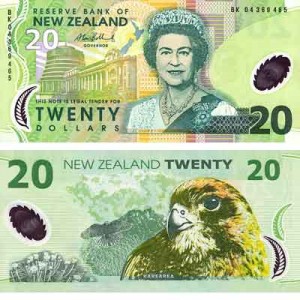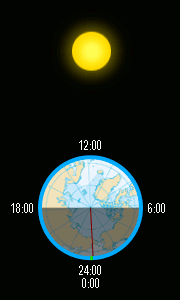Modern life is characterized by numbers. We incorporate them into our intuitive relationship with our surroundings and don’t think much about them until we go to a place where the units are different.
New Zealand uses the New Zealand dollar, which converts today to 84c US.
Time
Some degree of global standardization exists with time. pretty much every place on earth agrees that there are twenty four hours in a day, we just don’t agree on what to call them. It’s conventional here to use modulo 12 counting and differentiate morning from afternoon by AM and PM. Most other places use modulo 24. It takes me a while to internalize that 17:00 is late in the day without first converting it to 5:00pm.
The international date line is just to the East of NZ so that Auckland is the first major city in the world to experience the new date. I found this animation interesting and useful.
note the sun at high noon on the rotating earth. the IDL is the red line, fixed on the earth and rotating with it. As usual the devil is in the details, but the graphic illustrates why the IDL is necessary.
Right now it is a little after 1PM Monday here, but it is 07:00 Tuesday NZDT. If we walk the time zones to the East from New York, the time advances (gets later) until we pass through midnight somewhere around India, and begin the new day, Tuesday. Continuing on Eastward, we finally arrive at NZ 18 hours from NY. If we walk the time zones to the West, the time becomes earlier until we reach NZ six hours earlier in the day (seven time zones plus DST). But when we cross the IDL from West to East, we advance the date, yielding the same result: 07:00 Tuesday.
On the way there, the flight from San Francisco departs at 7:45PM Monday and arrives in Auckland at 05:45 Wednesday. Wednesday? It so happens that this route crosses both midnight and the IDL from the East, advancing the date twice. So, how long is the flight, two days? No. It arrives in Auckland at 05:45 + 03:00 = 8:45AM San Francisco time for a difference of 13 hours. Isn’t global navigation fun?
Temperature
Most countries use the metric Centigrade unit, while the USA still officially uses Farenheit, along with the other holdouts Jamaica, the Cayman Islands, Belize, the Bahamas, and Palau. It takes me a while to ‘think’ in Centigrade, so I cheat. My crutch: 10degC is jacket weather, 20degC is comfortable, and 30degC is very warm, New Yorkers might even say hot. That’s about all the range I’ll need in NZ.
Distance
A Kilometer is a little less than two thirds of a mile, so for a while I’ll be computing that in my head, too.
Speed
Thankfully, we all agree on the hour as the unit of time, so km/hr is converted to mph by the same factor as distance. 60mph is about 100km/hr.
Volume
No gallons of gasoline in NZ, instead liters of petrol. A liter is a little larger than a quart, so i generally use a factor of four to convert in my head, and then round down if figuring liters to partially compensate for the five percent error. This is handy when purchasing petrol by the liter.
Gas Mileage
The best is saved for last. Fuel economy is measured in NZ as liters per hundred kilometers. Not only are all the component units different, but the ratio is inverted, meaning those of us used to a larger number of mpg being better have to struggle with a smaller number of l/100km being better. 30mpg is about 8l/100km, 40mpg is about 6l/100km.
Summary
Life hasn’t always been so quantitative. The sixty minute hour has only been around since the invention of the mechanical clock displaying minutes near the end of the 16th century. It is unknown how 60 came to be chosen as the number of minutes in an hour and seconds in a minute. Here’s a good article on that.
In fact it is the development of quantification during the Renaissance that enabled Western Europe to dominate the world by being among the first, if not the first, to invent mechanical clocks, geometrically precise maps, double-entry bookkeeping, precise algebraic and musical notations, and perspective painting. If you have any interest in that, I highly recommend The Measure of Reality by Alfred Crosby. I found it fascinating.



Interesting stuff.
Two fun facts I learned on two trips to Asia can add a bit of, well, Seinfeldian nothingness:
1. When I flew from Tokyo to Atlanta, I got to Atlanta before I left Tokyo, time-wise.
2. When I flew from LA to Hong Kong, the jet went straight north along the Pacific Coast to the Bering Sea and Siberia and then back down the other side of the Pacific. A pilot explained that’s because of the curvature of the earth, but I just don’t see it.
Perhaps you can explain that in a future blog so I don’t have to Googlize it.